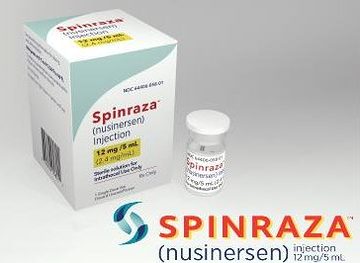Regular CSF Exams Urged Following Spinraza Treatment to Screen for Injection Side Effects, Study Suggests

Spinraza, SMA's first disease-modifying therapy.
The work-up of cerebrospinal fluid (CSF) samples from spinal muscular atrophy (SMA) patients treated with Spinraza (nusinersen) revealed mild increases in protein content, which were attributed to lumbar punctures used for testing and to the medication’s delivery by injection into the spinal canal, a study shows.
Although Spinraza’s administration seems to be safe and well-tolerated, the researchers recommend regular examinations of routine CSF parameters for people with SMA to screen for possible side effects.
The study, “Routine Cerebrospinal Fluid (CSF) Parameters in Patients With Spinal Muscular Atrophy (SMA) Treated With Nusinersen,” was published in the journal Frontiers in Neurology.
Spinraza, the first therapy approved for treating SMA by both the U.S. Food and Drug Administration and the European Medicines Agency, boasts several other firsts. For example, it is the first medicine that works by correcting defective RNA splicing, and the first nucleic acid therapeutic for a neurological disease.
However, because Spinraza is made up of an anti-sense oligonucleotide (ASO) — small synthetic, or man-made molecules — it cannot cross the blood-brain barrier (BBB), which protects the neural tissue from toxins and pathogens. Therefore, the therapy must be administered directly into the cerebrospinal fluid (CSF) by repeated lumbar punctures, known as spinal taps.
Since there is limited clinical experience with ASOs, not much is known about their possible effects on the blood-CSF barrier (BCB) or CSF flow, and on other CSF routine parameters.
“Diagnostic evaluation of inflammatory (infectious or non-infectious) or degenerative conditions, involving the brain, spinal cord, and meninges [three membranes that cover the brain and spinal cord], is possible by combining a set of values referred to as CSF routine parameters,” the researchers said.
The cerebrospinal fluid is a clear, colorless liquid that surrounds and cushions the brain and spinal cord. Each person has about 150 ml of this fluid and approximately 500 ml are produced each day. Hence, it is constantly being produced, circulated, and absorbed. Small amounts of blood proteins such as albumin — a protein made by the liver that helps keep fluid in the bloodstream so it doesn’t leak into other tissues — can diffuse into the CSF.
Routine examinations of CSF parameters allow physicians to monitor the health and circulation of the CSF, brain, and spinal cord. Infection, inflammation, or diseases like multiple sclerosis alter the normal values of white blood cells, protein, and lactate. They also can produce oligoclonal bands, which detect proteins called immunoglobulins that indicate central nervous system inflammation.
In this study, the researchers examined the routine CSF parameters of 60 SMA patients, ages 7–60, with types 1, 2, and 3.
CSF and serum samples were collected before the administration of Spinraza on treatment day 0 (first injection, or T1), and then on days 14 (T2), 28 (T3), 63 (T4), 180 (T5), 300 (T6), 420 (T7), and 540 (T8). Among the 60 participants, nine received eight injections of Spinraza, 17 received seven injections, 12 received six, 10 received five, and 12 received four.
A series of routine CSF parameters were analyzed, including white cell count, total protein, lactate, oligoclonal IgG bands (OCB), and CSF/serum quotients of albumin. The CSF/serum albumin ratio, or Qalb, is used to evaluate the permeability of the blood-brain barrier.
The researchers noted that the results of this study cannot be extrapolated to other patient groups.
“We only investigated a period of 18 months of treatment in these patients, and samples size decreased over time,” they said.
The most consistent finding in patients repeatedly injected with Spinraza was a mild increase in total protein and Qalb with succeeding lumbar punctures. The sole exception was total protein at the fourth injection, or T4.
According to the team, “the slight change in total CSF protein and Qalb may be caused by repeated lumbar puncture and/or intrathecal [spinal cord injection] administration of the drug.” In other words, the slight changes may be due to the mild trauma produced by the lumbar puncture procedure, in which the medicine is injected into the space under the middle membrane covering the spinal cord.
The researchers found an association between Qalb and total protein at baseline and SMA type (2 and 3), with higher levels of both parameters in the SMA type 3 subgroup.
“As clinical features vary widely between patients, especially in SMA type 3 (e.g., ambulatory vs. non-ambulatory), we speculate, that the association of baseline total protein and Qalb to SMA type is determined by age (as the SMA type 2 patients were younger than the SMA type 3 patients),” the researchers said.
One patient showed an increased white blood cell count, attributed to a coincidental systemic and meningeal viral infection. This abnormal value then normalized.
A 42-year-old SMA type 3 patient showed transient positive oligoclonal bands (OCBs) in the CSF, which indicate that the immune system has been activated. This screen can be especially valuable for the diagnosis of multiple sclerosis.
The precise cause of OCBs in this patient could not be determined, but the researchers hypothesized that a reaction to an unidentified molecule — possibly including the medicine itself — could explain it.
Overall, the current administration of Spinraza through spinal taps was found to be well-tolerated and safe, the researchers said.
“Examination of CSF routine parameters in 60 SMA patients (types 1, 2, and 3, aged 7–60 years) treated with nusinersen revealed that repeated intrathecal administration of the drug seems to be in general safe and well-tolerated,” they said.
“Our data suggest that a systematic examination of routine CSF parameters in patients in which intrathecal ASOs are administered is important to obtain information on possible side effects and to gain further insights into intrathecal processes,” they added.







